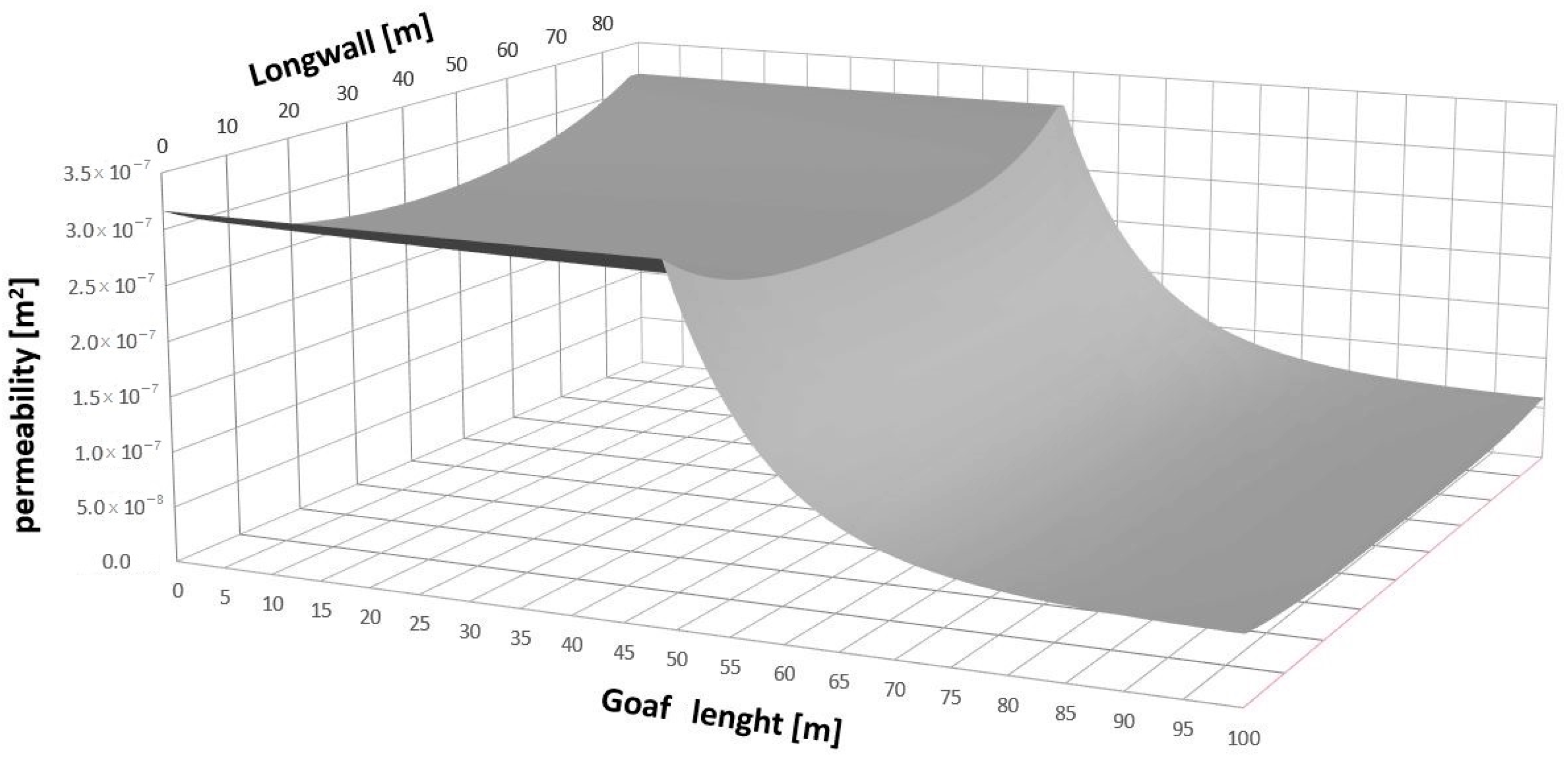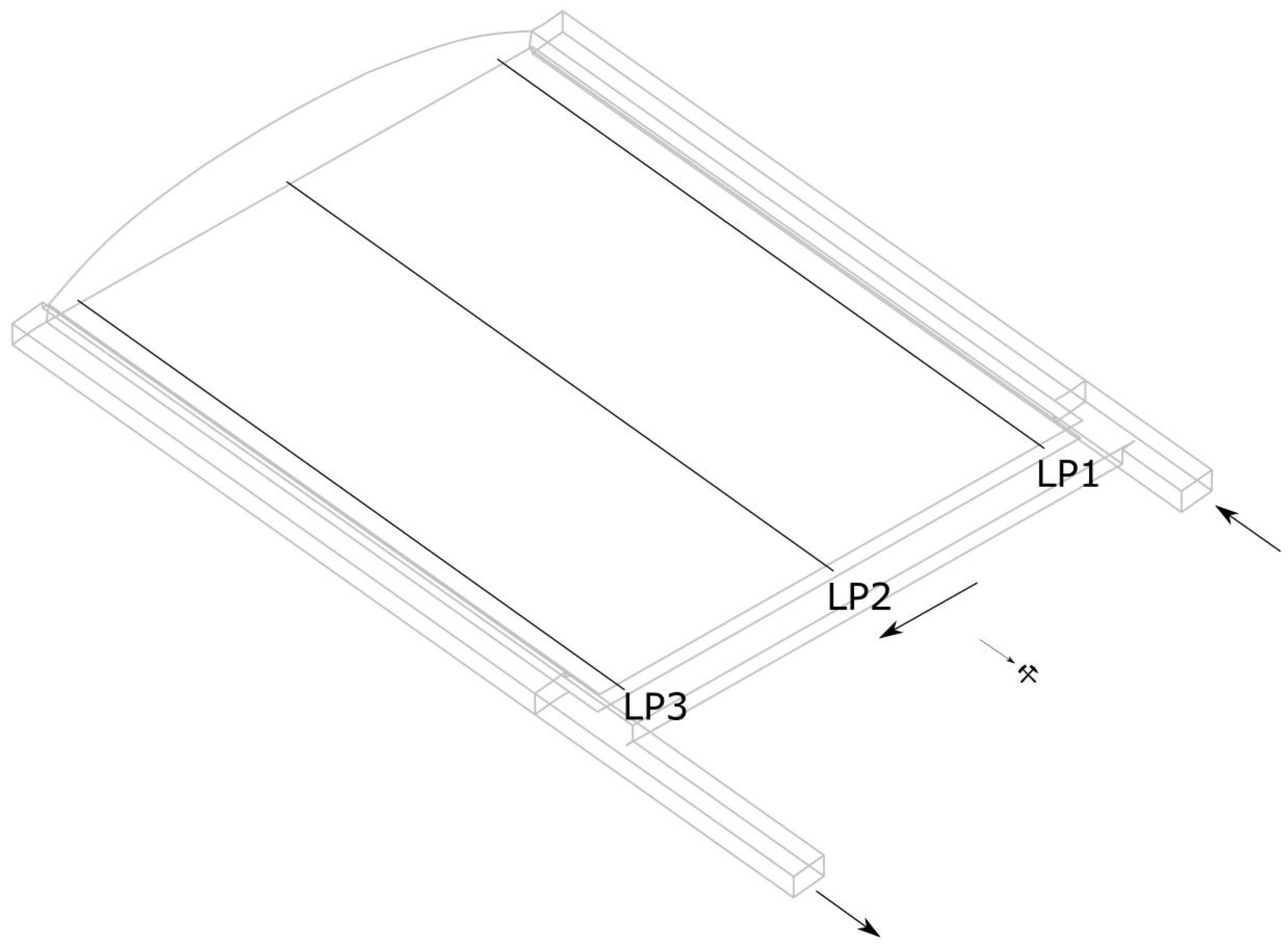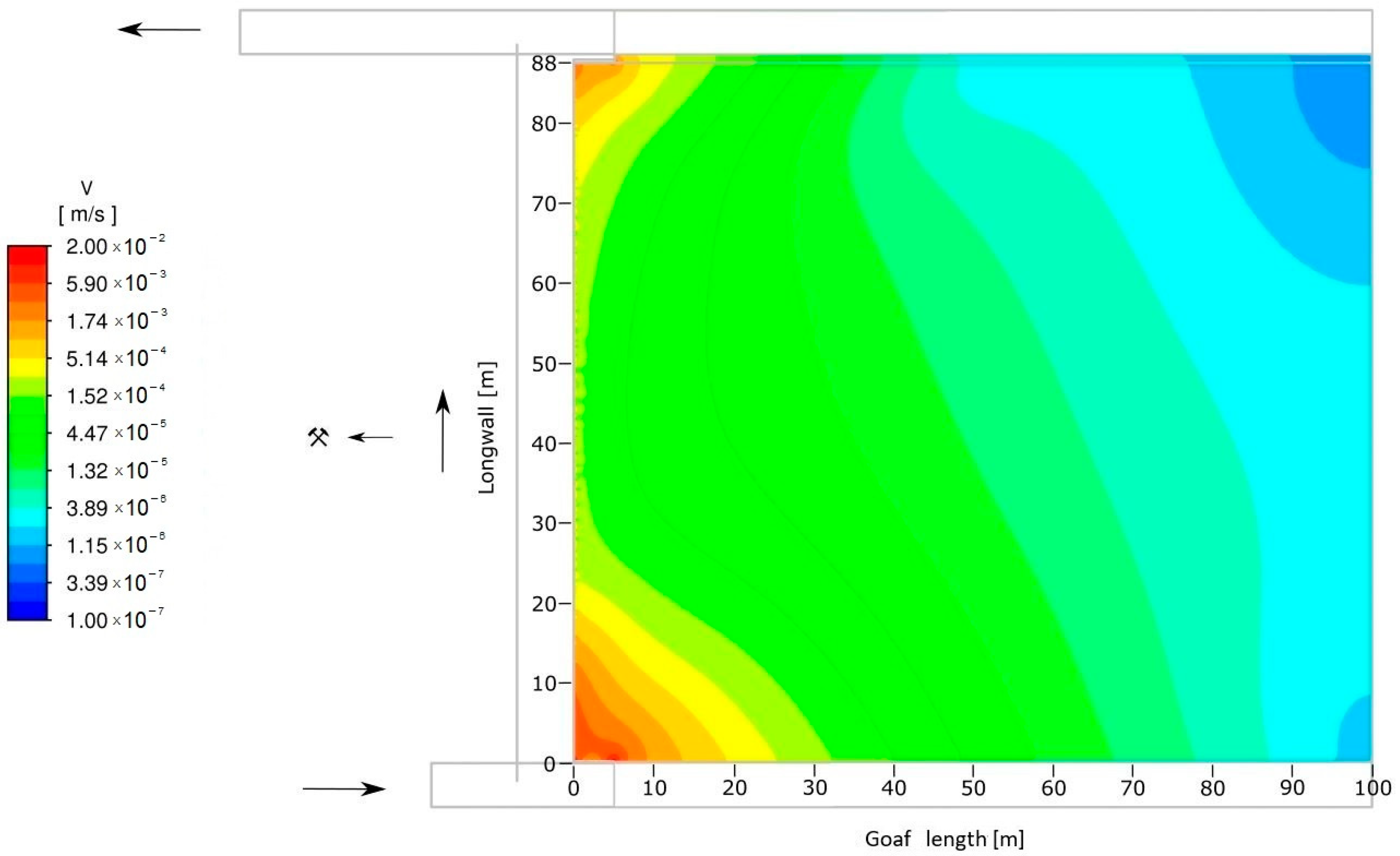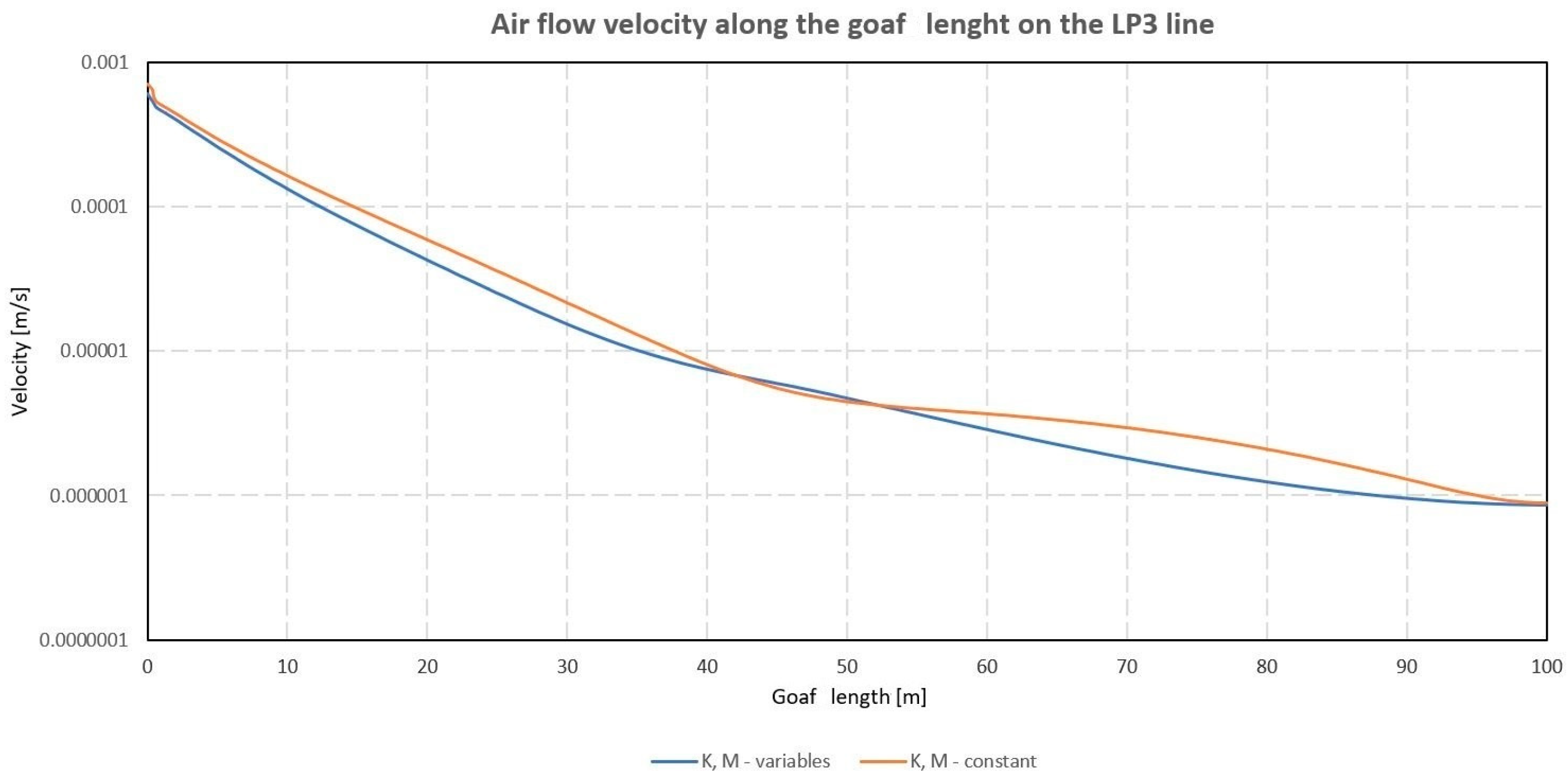Numerical Investigation of Air Flow in Goaf While Mapping Its Flow Parameters
Abstract
:1. Introduction
2. Numerical Research
2.1. Geometry of Numerical Model
2.2. Computational Grid
2.3. Boundary Conditions
2.4. Numerical Calculations
- A total of 532 servers equipped with 192 GB of RAM each;
- A total of 256 servers with 384 GB of RAM each;
- A total of 9 servers with 8 NVIDIA Tesla V100 cards each.
2.5. Results of Air Flow Numerical Simulation in the Area of the Longwall and Goafs
3. Conclusions
Funding
Data Availability Statement
Acknowledgments
Conflicts of Interest
References
- Yi, H.; Kim, M.; Lee, D.; Park, J. Applications of Computational Fluid Dynamics for Mine Ventilation in Mineral Development. Energies 2022, 15, 8405. [Google Scholar] [CrossRef]
- Vives, J.; Bascompta, M.; Felipe, J.J.; Sanmiquel, L. Computational Fluid Dynamics (CFD) study to optimize the auxiliary ventilation system in an underground mine. DYNA 2022, 89, 84–91. [Google Scholar] [CrossRef]
- Jiang, W.; Xu, X.; Wen, Z.; Wei, L. Applying the similarity theory to model dust dispersion duringcoal-mine tunneling. Process Saf. Environ. Prot. 2021, 148, 415–427. [Google Scholar] [CrossRef]
- Janus, J. Assessment of the possibilities of using laser scanning for numerical models constructions. Trans. Strat. Mech. Res. Inst. 2015, 17, 1–2. [Google Scholar]
- Skotniczny, P. Three-Dimensional Numerical Simulation of the Mass Exchange Between Longwall Headings and Goafs, in the Presence of Methane Drainage in A U-Type Ventilated Longwall. Arch. Min. Sci. 2013, 58, 3. [Google Scholar]
- Biswal, P.K.; Parida, D.; Mishra, G.; Sahoo, A.K. Study of air flow pattern in mine model gallery and its validation using CFD modelling. World Sci. News 2019, 130, 1–24. [Google Scholar]
- Lolon, S.; Brune, J.F.; Bogin Jr, G.E.; Grubb, J.W.; Juganda, A. Understanding Gob Outgassing Associated with Pressure Disturbances in Longwall Mine. In Proceedings of the 16th North American Mine Ventilation Symposium, Golden, CO, USA, 17–22 July 2017. [Google Scholar]
- Dziurzyński, W. Prognozowanie Procesu Przewietrzania Kopalni Głębinowej w Warunkach Pożaru Podziemnego; Instytut Gospodarki Surowcami Mineralnymi i Energią PAN: Kraków, Poland, 1998. [Google Scholar]
- Janus, J. Air flow modeling in longwall area. Trans. Strat. Mech. Res. Inst. 2020, 22, 1–4. [Google Scholar]
- Ansys Inc. Ansys Fluent Theory Guide; Ansys Inc.: Canonsburg, PA, USA, 2019. [Google Scholar]
- Janus, J. Air flow modeling on the geometry reflecting the actual shape of the longwall area and goafs. Arch. Min. Sci. 2021, 66, 4. [Google Scholar]
- Pokorný, j.; Brumarová, L.; Kučera, P.; Martinka, J.; Thomitzek, A.; Zapletal, P. The effect of Air Flow Rate on Smoke Stratification in Longitudinal Tunnel Ventilation. Acta Montan. Slovaca 2019, 24, 3. [Google Scholar]
- Ren, T.; Balusu, R.; Claassen, C. Computational Fluid Dynamics Modelling of Gas Flow Dynamics in Large Longwall Goaf Areas. In Proceedings of the 35th APCOM Symposium, Wollongong, Australia, 24–30 September 2011. [Google Scholar]
- Wala, M.A.; Vytla, S.; Taylor, C.D.; Huang, G. Mine face ventilation: A comparison of CFD results against benchmark experiments for the CFD code validation. Min. Eng. 2007, 59, 49–55. [Google Scholar]
- Szlązak, J. Wpływ Uszczelniania Chodników Przyścianowych na Przepływ Powietrza Przez Zroby. Ph.D. Thesis, AGH Kraków, Kraków, Poland, 1980. [Google Scholar]











| Height [m] | Width [m] | Length [m] | Slope [°] | |
|---|---|---|---|---|
| Maingate | 3.8 | 5.5 | 29.0 | – |
| Longwall | 2.9 | 6.6 | 88.0 | 8.0 |
| Tailgate | 3.8 | 5.5 | 29.0 | – |
| Goafs | 12.4 | 88.0 | 100.0 | 8.0 |
Disclaimer/Publisher’s Note: The statements, opinions and data contained in all publications are solely those of the individual author(s) and contributor(s) and not of MDPI and/or the editor(s). MDPI and/or the editor(s) disclaim responsibility for any injury to people or property resulting from any ideas, methods, instructions or products referred to in the content. |
© 2023 by the author. Licensee MDPI, Basel, Switzerland. This article is an open access article distributed under the terms and conditions of the Creative Commons Attribution (CC BY) license (https://creativecommons.org/licenses/by/4.0/).
Share and Cite
Janus, J. Numerical Investigation of Air Flow in Goaf While Mapping Its Flow Parameters. Processes 2023, 11, 987. https://doi.org/10.3390/pr11040987
Janus J. Numerical Investigation of Air Flow in Goaf While Mapping Its Flow Parameters. Processes. 2023; 11(4):987. https://doi.org/10.3390/pr11040987
Chicago/Turabian StyleJanus, Jakub. 2023. "Numerical Investigation of Air Flow in Goaf While Mapping Its Flow Parameters" Processes 11, no. 4: 987. https://doi.org/10.3390/pr11040987





